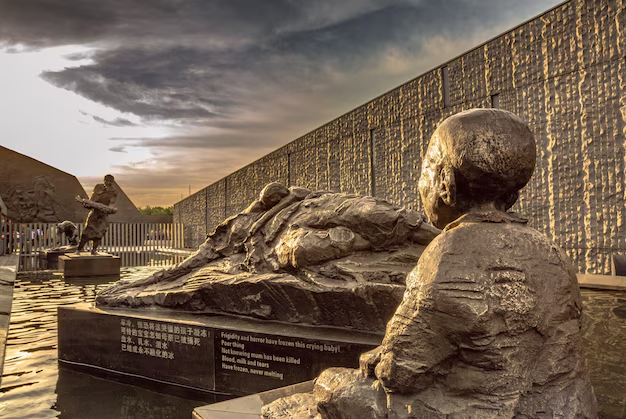The Memorial Hall of the Victims in Nanjing Massacre by Japanese Invaders, located in Nanjing, China, is a poignant and historically significant site that commemorates the tragic events of the Nanjing Massacre during World War II. Opened on December 13, 1985, and expanded in 2007, this memorial serves as both a museum and a place of reflection, honoring the memory of the estimated 300,000 victims killed by Japanese forces in 1937-1938. If you’re planning a visit, here’s a detailed travel guide to help you make the most of your experience.








Travel Guide to the Memorial Hall of the Victims in Nanjing Massacre by Japanese Invaders
Overview
Location: No. 418 Shuiximen Street, Jianye District, Nanjing, Jiangsu Province, China
Opening Hours: Tuesday to Sunday, 8:30 AM – 4:30 PM (closed on Mondays, except for public holidays)
Admission: Free (bring a valid ID or passport for entry; reservations may be required during peak seasons)
Best Time to Visit: Spring (March-May) or Autumn (September-November) for comfortable weather
The Memorial Hall is not just a tourist attraction but a solemn reminder of history. It combines indoor exhibits, outdoor sculptures, and excavated sites to provide a comprehensive understanding of the massacre.
How to Get There
Nanjing is well-connected, and the Memorial Hall is easily accessible:
By Metro: Take Line 2 to Yunjinlu Station (Exit 2). The hall is a 5-10 minute walk from there.
By Bus: Routes 204, 166, or 7 stop near the Memorial Hall (look for “Jiangdongmen” stop).
By Taxi/Rideshare: A ride from downtown Nanjing (e.g., Xinjiekou) costs around 20-30 RMB and takes 15-20 minutes.
From Nanjing Railway Station: Take Metro Line 1 to Xinjiekou, transfer to Line 2, and get off at Yunjinlu (total travel time: ~40 minutes).
What to Expect
The Memorial Hall is divided into several sections, each offering a unique perspective on the tragedy:
Exhibition Hall: Displays historical documents, photographs, survivor testimonies, and artifacts like weapons and personal belongings. The atmosphere is somber, with dim lighting and detailed captions in Chinese and English.
Outdoor Memorial Area: Features statues like the “Peace Statue” and “The Wailing Wall,” inscribed with victims’ names. The open space invites quiet reflection.
Mass Grave Site: An excavated pit reveals skeletal remains, a stark reminder of the atrocities. It’s a deeply moving experience, so prepare yourself emotionally.
Peace Park: A serene area with greenery and a dove-themed sculpture symbolizing hope and reconciliation.
The museum uses multimedia, including videos and audio guides (available in multiple languages), to narrate the events. Plan to spend 2-3 hours to fully explore.
Tips for Visiting
Dress Respectfully: This is a memorial site, so avoid loud clothing or casual beachwear. Comfortable shoes are recommended as there’s a fair amount of walking.
Be Prepared Emotionally: The exhibits are graphic and detailed, including images of violence and suffering. It’s not suitable for very young children.
Photography Rules: Photography is allowed outdoors but prohibited in the indoor exhibition halls. Respect the signs and staff instructions.
Language: Most signage is bilingual (Chinese and English), but bringing a translation app can help with smaller details.
Crowds: The site can get busy during weekends, holidays, or December 13 (National Memorial Day). Visit early in the morning for a quieter experience.
Nearby Attractions
Make a day of your visit by exploring nearby sites:
Nanjing City Wall (15-minute drive): A well-preserved section of the ancient wall with scenic views.
Qinhuai River (20-minute drive): Enjoy a boat ride or stroll along this historic waterway.
Presidential Palace (25-minute drive): A glimpse into China’s political history.
For a meal, head to nearby Fuzimiao (Confucius Temple) area, where you can try local Nanjing specialties like duck blood vermicelli soup or salted duck.
Practical Information
Weather: Nanjing can be humid and hot in summer (up to 35°C/95°F) or chilly in winter (around 0°C/32°F). Check the forecast and dress accordingly.
Facilities: Restrooms, a small café, and a bookstore are available on-site. The café offers light snacks and drinks, but options are limited.
Accessibility: The site is wheelchair-friendly with ramps and elevators in key areas.
Cultural Etiquette
The Memorial Hall is a place of mourning and respect. Keep your voice low, avoid disruptive behavior, and take time to reflect on the historical weight of the site. Many visitors leave flowers or messages at the memorials as a gesture of remembrance.
Why Visit?
A trip to the Memorial Hall is more than just sightseeing—it’s an educational and emotional journey. It offers insight into a dark chapter of history, fosters understanding of humanity’s resilience, and underscores the importance of peace. Whether you’re a history enthusiast or a thoughtful traveler, this site leaves a lasting impression.
Plan your visit with an open mind and a respectful heart. The Memorial Hall of the Victims in Nanjing Massacre stands as a testament to memory, survival, and the hope for a better future. Safe travels!













